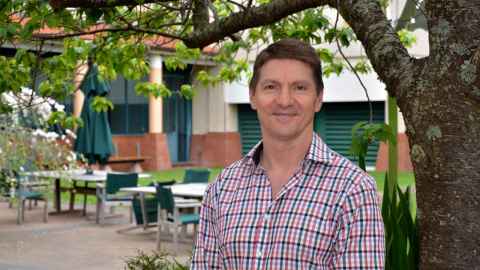Take 10 with... Winston Byblow
Professor Winston Byblow from the Department of Exercise Sciences gives us 10 minutes of his time to discuss his research into stroke recovery.

1. Describe your research topic to us in 10 words or less.
Understanding, predicting and improving stroke recovery.
2. Now explain it in everyday terms!
Over 6,000 New Zealanders experience a stroke each year and two-thirds of these people experience weakness and loss of function in the hand, arm and leg which affects their ability to return to work and live independently. Ten years ago, we were no better than chance at predicting the extent of hand and arm recovery that someone might make. The research we have done in Auckland has shown that by using better techniques, prediction accuracy can be above 80%.
3. Describe some of your day-to-day research activities.
My research examines the structure and function of the nervous system in healthy people as well as those with brain injury or disease. The neurological conditions include stroke, traumatic brain injury, cerebral palsy, Parkinson’s disease, dystonia, complex regional pain syndrome, and one or two others. These conditions affect our ability to move. My research examines the neurophysiological basis of the deficit. We then propose and explore novel interventions that we think may effectively normalise the deficit, with the aim of making lasting clinical or behavioural improvements.
Most of the research is done noninvasively and painlessly using magnetic stimulation of the brain motor regions, and by recording the properties of responses from that stimulation in the muscles of interest, from electrodes placed over the skin. A companion technique is to use MRI to visualise the areas of the brain of the people we are working with, to better understand which regions of the brain have been affected by age, injury or disease, and how these areas functionally respond to our interventions.
4. What do you enjoy most about your research?
Working with my students, fellows and colleagues, and with our research participants, by helping them understand more about their brain and its potential for change throughout life. And in fairness, I really enjoy crunching numbers; whether it’s programming a simple bit of code, or running statistical analyses. It’s like candy!
5. Tell us something that has surprised you in the course of your research.
If you express stroke recovery in terms of how impaired a person is initially after stroke, what you find is that a majority of patients exhibit exactly the same recovery dynamic regardless of where they start from and where they end up. Most people recover a fixed proportion (remarkably, almost exactly 70%) of what they lose. This is true for hand and arm recovery, leg and walking recovery, and to some extent language and other cognitive domains, and possibly others. Proportional recovery has been found recently by independent groups all around the world working in different clinical environments. Our research has identified within the first few days after stroke, which patients will make a proportional recovery of their affected hand and arm within three months, from patients who experience a poor recovery (well below 70%). This finding also provided clues which may help us identify the biological precursor for proportional recovery. The very existence of proportional recovery means that current stroke rehabilitation practice does not interact with this powerful spontaneous biological recovery process. Physical and occupational therapy are incredibly important for helping people regain independence and return home and to work, and all those are great things, but the door remains wide open for interacting with, and improving upon, 70%.
6. What questions have emerged as a result?
I think the biggest challenge I’ve ever faced has been trying to answer the seemingly simple question – “Why 70?”
7. How have you approached any challenges you’ve faced in your research?
I try to keep an open mind, and begin new collaborations in areas I would never have imagined starting a few years ago.
8. What kind of impact do you hope your research will have?
I hope we will continue to make discoveries that inform and improve clinical practice, as we have already done by working with clinicians and patients at Auckland City Hospital, over the course of several Health Research Council of NZ funded projects.
9. If you collaborate across the faculty or University, who do you work with and how does it benefit your research?
The ideas about stroke recovery and outcome prediction are being driven foremost by my colleague Associate Professor Cathy Stinear in the Department of Medicine, and also with clinical guidance of Professor Alan Barber, the Neurological Foundation of New Zealand Chair of Clinical Neurology.
Cathy leads a team in Medicine which has developed our prediction algorithm and implemented it in the real world, first at Auckland Hospital and now by attracting the interest of hospitals around the world. Her efforts bring our team and the University tremendous exposure. Cathy, Alan and I have been working together on stroke recovery and rehabilitation projects for more than 10 years. Long may it continue.
I collaborate with many great colleagues in Exercise Sciences: Greg Anson, Nick Gant, Angus McMorland, Jim Stinear, and I’ve worked with some outstanding colleagues in the School of Psychology over the years. I very much enjoy projects with international colleagues when on research and study leave (mine or theirs), and I make space and time for those wherever and whenever I can. I am an investigator in two existing Centres of Research Excellence – Brain Research New Zealand and MedTech, which offer more opportunities for collaboration than are possible, or wise!
10. What one piece of advice would you give your younger, less experienced research selves?
Neurophysiological research is technically complex. I remind my students that a good and successful experiment requires 90% of the time on preparation and set up, and 10% on actual data collection. Embrace and enjoy the 90% which is under your control. The rest, you’re just along for the ride!